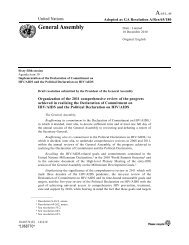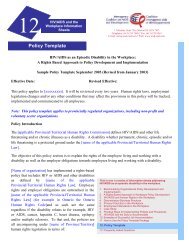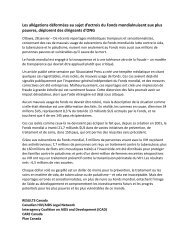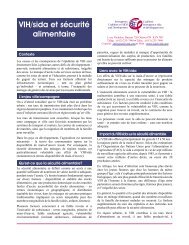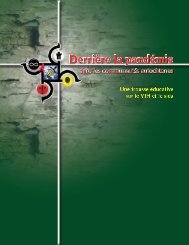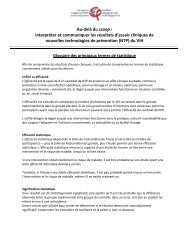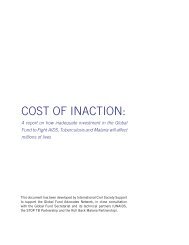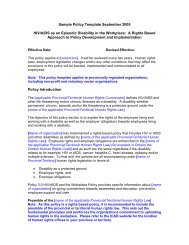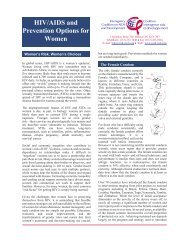Dennis, Mary Kate. 2009. “Risk and Protective Factors for HIV/AIDS <strong>in</strong> Native Americans:Implications for Preventative Intervention.” Social Work 54(2): 145.Dias, Giselle and Peter Coll<strong>in</strong>s. nd. An Inter-Sectoral Strategy to Address HIV/AIDS andHepatitis C <strong>in</strong> Ontario Prisons. Prepared for PASANDilley, J. and Decarlo, P. (2001). CAPS Factsheet: How Does Mental Health Affect HIVPrevention? Retrieved January 14, 2009 from http://www.caps.ucsf.edu/pubs/FS/mentalhealth.php.Dorfman, L, Wallack, L, Woodruff, K (2005). More than a message: Fram<strong>in</strong>g public healthadvocacy to change corporate practices. Health Education and Behaviour, 32(3),320 – 336.Duran, Bonnie and Kar<strong>in</strong>a L. Walters. 2004. “HIV/AIDS Prevention <strong>in</strong> "Indian Country":Current Practice, Indigenist Etiology Models, and Postcolonial Approaches toChange.” AIDS Education and Prevention 16(3): 187.Duran, Bonnie; Marc Bulterys; Jon Iralu; Cheryl Graham; et al 2000. “AmericanIndians with HIV/AIDS: Health and Social Service Needs, Barriers to care, andSatisifaction with Services among a Western Tribe.” American Indian and AlaskaNative Mental Health Research 9(2): 22.Ell<strong>in</strong>gson, Lyndall and Carol Odo. 2008. “HIV Risk Behaviors among Mahuwah<strong>in</strong>e (NativeHawaiian Transgender Women.” AIDS Education and Prevention 20(6): 558.Faas, Lily, Alexis Rodríguez-Acosta,and Gloria Echeverría de Pérez. 1999. “HIV/STDtransmission <strong>in</strong> gold-m<strong>in</strong><strong>in</strong>g areas of Bolívar State, Venezuela: Interventions fordiagnosis, treatment, and prevention.” Revista Panamericana de Salud Publica/Pan American Journal of Public Health 5(1)Gatali, M. and C. Archibald. 2003. “Women and HIV” In Women’s Health SurveillanceReport: A Multi-dimensional Look at <strong>the</strong> Health of Canadian Women. Ottawa:M<strong>in</strong>ister of Health CanadaGilles, Marisa T., Jan E. Dick<strong>in</strong>son, Alison Ca<strong>in</strong>, Kate A. Turner, Rosemary McGuck<strong>in</strong>,Richard Loh, Susan L. Prescott and Martyn A. French. 2007. “Per<strong>in</strong>atal HIVtransmission and pregnancy outcomes <strong>in</strong> <strong>in</strong>digenous women <strong>in</strong> WesternAustralia.” Australian and New Zealand Journal of Obstetrics and Gynaecology47: 362–367.Hamill, Shelley and Michael Dickey. 2005. “Cultural Competence: What Is Needed <strong>in</strong>Work<strong>in</strong>g With Native Americans With HIV/AIDS?” Journal of <strong>the</strong> Association ofNurses <strong>in</strong> AIDS Care 16(4): 64-69.Health Canada. 2004. HIV/AIDS Epi Update - May 2004, HIV/AIDS Among Aborig<strong>in</strong>alPeoples <strong>in</strong> Canada: A Cont<strong>in</strong>u<strong>in</strong>g Concern. Onl<strong>in</strong>e: http://www.phac-aspc.gc.ca/publicat/epiu-aepi/epi_update_may_04/9-eng.php110
Public Health Agency Health of Canada. 2004. “HIV/AIDS among Aborig<strong>in</strong>al Persons<strong>in</strong> Canada: A Cont<strong>in</strong>u<strong>in</strong>g Concern.” HIV/AIDS EPI Updates. Ottawa: Centre forInfectious Disease Prevention and ControlHernández-Rosete, Daniel, Olivia Maya García, Enrique Bernal, Xóchitl Castañeda andGeorge Lemp. 2008. “Migration and ruralization of AIDS: reports on vulnerabilityof <strong>in</strong>digenous communities <strong>in</strong> Mexico.” Revista de Saúde Pública 42(1):131-8Hill, Donna M. 2008. “Aborig<strong>in</strong>al women liv<strong>in</strong>g with HIV/AIDS : An empowermentperspective.” Masters <strong>the</strong>sis, University of British Columbia.Hill, Donna M. 2003. “HIV/AIDS Among Canada’s First Nations People: A Look atDisproportionate Risk Factors as Compared to <strong>the</strong> Rest of Canada.” The CanadianJournal of Native Studies 23(2): 349-359.Hogg, Robert S., Steffanie Strathdee, Thomas Kerr, Evan Wood and Robert Remis. 2005.“HIV Prevalence among Aborig<strong>in</strong>al British Columbians.” Harm Reduction Journal2: 26.<strong>Interagency</strong> Coalition on AIDS and Development (ICAD). HIV/AIDS and <strong>the</strong> BroaderDeterm<strong>in</strong>ants of Health <strong>in</strong> an Aborig<strong>in</strong>al Context – Fact Sheet. Onl<strong>in</strong>e: http://icadcisd.com/pdf/Determ<strong>in</strong>ants_of_Health_Aborig<strong>in</strong>al_Fact_Sheet_FINAL_EN.pdf.Johnson, Jeannette L., Jan Gryczynski and Shelly A. Wiechelt. 2007. “HIV/AIDS, SubstanceAbuse, and Hepatitis Prevention Needs of Native Americans Liv<strong>in</strong>g <strong>in</strong> Baltimore:In <strong>the</strong>ir Own Words.” AIDS Education and Prevention 19(6): 531.Jolly, S. (2009). Why Talk About Pleasure? Retrieved December 23, 2009 from http://www.ids.ac.uk/go/news/why-talk-about-pleasure.Kaufman, Carol E., Laura Shelby, Debra J. Mosure, Jeanne Marrazzo, David Wong, Lori DeRavello, Stephanie Craig Rush<strong>in</strong>g, Victoria Warren-Mears, Lisa Neel, Sara Jump<strong>in</strong>gEagle, Scott Tulloch, Franc<strong>in</strong>e Romero, Sarah Patrick, and James E. Cheek, For TheTask Force On STD Prevention And Control Among American Indians And AlaskaNatives. 2007. “With<strong>in</strong> <strong>the</strong> Hidden Epidemic: Sexually Transmitted Diseases andHIV/AIDS Among American Indians and Alaska Natives.” Sexually TransmittedDiseases 34(5)Lapidus, Jodi A., Jeanne Bertolli, Karen McGowan and Patrick Sullivan. 2006. “HIV-Related Risk Behaviors, Perceptions of Risk, HIV Test<strong>in</strong>g, and Exposure toPreventive Messages and Methods Among Urban American Indians and AlaskaNatives.” AIDS Education and Prevention 18(6): 546.Lark<strong>in</strong>, June, Sarah Flicker, Ruth Koleszar-Green, Susan M<strong>in</strong>tz, Michelle Dagn<strong>in</strong>o, andClaudia Mitchell. 2007. “HIV Risk, Systemic Inequities, and Aborig<strong>in</strong>al Youth:Widen<strong>in</strong>g <strong>the</strong> Circle for HIV Prevention Programm<strong>in</strong>g” Canadian Journal of PublicHealth 179111
- Page 6 and 7:
Facilitator’s Materials..........
- Page 8 and 9:
What is this Educational Resource f
- Page 10 and 11:
experienced traumatic life events s
- Page 12 and 13:
Getting Ready to Facilitate this Ed
- Page 14 and 15:
Table 1: Potential Audiences and Ad
- Page 16 and 17:
Overview of Workshop AgendaOutlined
- Page 18 and 19:
WorkshopEtiquette(Social Norms)5 Mi
- Page 20 and 21:
Fred’s Story:LandscapeThinking(co
- Page 22 and 23:
Facilitator’s Note:It is possible
- Page 24 and 25:
Facilitator’s Note:Resiliency mea
- Page 27 and 28:
Participant MaterialsActivity Mater
- Page 29 and 30:
Individual LevelIndividual LevelInd
- Page 31 and 32:
Family LevelIndividual LevelFamily
- Page 33 and 34:
Family LevelFamily LevelFamily Leve
- Page 35 and 36:
Community LevelCommunity LevelCommu
- Page 37 and 38:
Community LevelCommunity LevelCommu
- Page 39 and 40:
Systemic LevelSystemic LevelSystemi
- Page 41 and 42:
Systemic LevelSystemic LevelSystemi
- Page 43 and 44:
Systemic LevelSystemic LevelSystemi
- Page 45 and 46:
Systemic LevelArmand’s StoryArman
- Page 47 and 48:
Activity Materials: Resiliency Card
- Page 49 and 50:
Community Healing and Self-Determin
- Page 51 and 52:
Cultural ContinuityYou live in a co
- Page 53 and 54:
Building Community CapacityEveryone
- Page 55 and 56:
GIPA and ResearchA few years ago, t
- Page 57:
Handout #1: HIV Basics 11CATIE. 201
- Page 62 and 63: 10/21/2010Activity Purpose• Incre
- Page 65 and 66: 9/27/2010Activity InstructionsActiv
- Page 67 and 68: 9/27/2010Questions for Vulnerabilit
- Page 69 and 70: 9/27/2010Fred’s StoryHas no fridg
- Page 71 and 72: 9/27/2010Understanding Health Inequ
- Page 74 and 75: 9/27/2010Root Causes: BroaderDeterm
- Page 76 and 77: 9/27/2010Broader Determinants ofAbo
- Page 80 and 81: Facilitator’s Note:These backgrou
- Page 82 and 83: Gender and Gender Inequalities• G
- Page 84 and 85: approach must be undertaken with in
- Page 86 and 87: through collaboration and shared re
- Page 88 and 89: Diagram 1: Factors that affect HIVv
- Page 90 and 91: Card Key Issues Affecting Vulnerabi
- Page 92 and 93: Card Key Issues Affecting Vulnerabi
- Page 94 and 95: Card Key Issues Affecting Vulnerabi
- Page 96 and 97: Individual LevelIssue Exploration T
- Page 99 and 100: Card Key Protective Factors Suggest
- Page 101 and 102: Card Key Protective Factors Suggest
- Page 103 and 104: Glossary
- Page 105 and 106: Gender norms refer to the expectati
- Page 107 and 108: About the AuthorsLia De Pauw, MHSc,
- Page 109: Bouey, Paul D., and Betty E. S. Dur
- Page 113 and 114: Mill, Judy E., Randy C. Jackson, Ca
- Page 115 and 116: Scanlon, K., Travers, R., Humberto,



